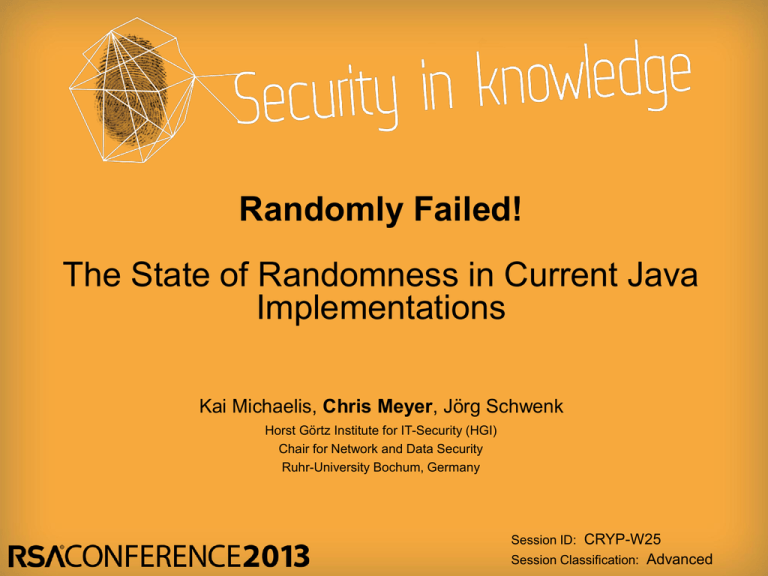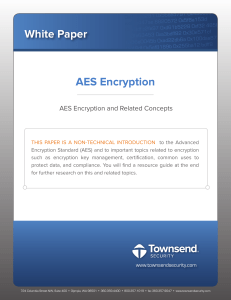Randomly Failed! The State of Randomness in Current Java
Anuncio

Randomly Failed! The State of Randomness in Current Java Implementations Kai Michaelis, Chris Meyer, Jörg Schwenk Horst Görtz Institute for IT-Security (HGI) Chair for Network and Data Security Ruhr-University Bochum, Germany Session ID: CRYP-W25 Session Classification: Advanced How Random are Java PRNGs? Source: http://www.xkcd.com Spoiler Slide ► At least, thankfully not! ► Inspected PRNGs ► ► ► ► Apache Harmony GNU Classpath OpenJDK The Legion of Bouncy Castle ► Methodology ► Code/algorithm inspection ► Blackbox Tests (Dieharder, STS, …) ► Broad range of code/algorithm quality ► The good ► The bad ► And the ugly Source: http://www.memegenerator.net Operation Sketch of a PRNG Entropy Source B Entropy Source A Focus of inspection Entropy Source C Random number Seed Seeding Generating pseudo-random numbers (normally invoked only once) (invoked multiple times) Results: Apache Harmony ► PRNG ► SHA-1 based algorithm: Seed, Counter, Internal State ► Backup seeding facility (Entropy Collector) ► (under Unix): Unix-Time, Processor Time, Pointer value (Heap) ► Weaknesses ► Self-seeding SecureRandom suffers from implementation bug ► Pointer into state buffer not properly adjusted ► Entropy reduced to 64 bits ► Directly affects the Android platform ► Backup seeding facility (Entropy Collector) suffers from multiple implementation bugs ► MSB set to 0 (reason for this remains unclear) ► Inappropriate modular reduction (signed/unsigned integers) ► Entropy reduced to 31 bits (worst case) Results: Apache Harmony Quality of Entropy Collector ► Worst-Case scenario ► 2 consecutive bytes mark a single point ► 10 MiB generated Seed Results:GNU Classpath ► PRNG ► SHA-1 based algorithm: Seed, Internal State ► Backup seeding facility (Entropy Collector) ► 8 Threads increment independent counters (c1..c8) ► Seed = c1 XOR c2 XOR …. c8 ► Weaknesses ► Repeated use of same IV ► Predictable internal states: only 20 of 32 bytes unknown ► Backup seeding facility (Entropy Collector) can be influenced ► High load prevents threads execution Results: GNU Classpath Quality of Entropy Collector ► Worst-Case scenario ► 2 consecutive bytes mark a single point ► 10 MiB generated Seed Results: OpenJDK ► PRNG ► SHA-1 based algorithm: Seed, Internal State, Fixed-state protection ► Backup seeding facility (Entropy Collector) ► ► ► ► ► Counter incrementation, System.properties Noise threads (keep the scheduler busy) S-Boxing counter Enforcing mandatory runtime and counter incrementation Slow…. ► Weaknesses ► No obvious weakness Results: Bouncy Castle ► PRNG ► Multiple SecureRandom replacements ► SHA-1 based algorithm: Seed, Internal State, Counter ► VMPC based algorithm ► Backup seeding facility (Entropy Collector) ► Counter incrementation ► Producer and Consumer Threads ► Slow and fast operation mode ► Weaknesses ► VMPC known to be vulnerable to distinguishing attacks Conclusion ► PRNGs are only as good as the seed’s entropy ► Software Entropy Collectors are mostly not suitable for cryptographic purposes ► Broad range of code/algorithm quality ► Fixed & limited size of internal states ► Some implementations are only susceptible to the outlined vulnerabilities if no OS entropy is available In critical environments ► Prevent usage of PRNGs ► Exclusively rely on hardware ECs/RNGs Random Questions? Chris Meyer [email protected] http://armoredbarista.blogspot.com http://www.nds.rub.de/chair/people/cmeyer Source: http://www.troll.me Efficient Vector Implementations of AES-based Designs: A Case Study and New Implementations for Grøstl Severin Holzer-Graf, Thomas Krinninger, Martin Pernull, Martin Schläffer1 , Peter Schwabe2 , David Seywald, Wolfgang Wieser IAIK, Graz University of Technology, Austria [email protected] Digital Security Group, Radboud University Nijmegen, Netherlands Research Center for Information Technology Innovation, Academia Sinica, Taiwan [email protected] CT-RSA 2013 Contents 1 Motivation 2 Short Description of Grøstl 3 Storing the Grøstl State 4 New Grøstl Implementations 5 Conclusion Martin Schläffer (CT-RSA 2013) Vector Implementations of AES Designs 2 / 27 Motivation Outline 1 Motivation 2 Short Description of Grøstl 3 Storing the Grøstl State 4 New Grøstl Implementations 5 Conclusion Martin Schläffer (CT-RSA 2013) Vector Implementations of AES Designs 3 / 27 Motivation Motivation Many AES-based hash functions have been submitted to the NIST SHA-3 competition [Nat07] Fast using Intel AES-NI instructions, slow otherwise!? More difficult to implement (or to improve performance)? Learn lessons to improve new AES-based designs Martin Schläffer (CT-RSA 2013) Vector Implementations of AES Designs 4 / 27 Motivation AES-Based Hash Functions AddRoundKey SubBytes ShiftRows MixColumns k00 k01 k02 k03 k10 k11 k12 k13 S(x) k20 k21 k22 k23 k30 k31 k32 k33 AES [Nat01]: 4x4 state of bytes (128-bit) Advantages: very well analyzed building blocks proofs against linear and differential attacks simple analysis (wide trails) fast using AES instruction Disadvantages: much larger state needed for 256-, 512-bit hash function AES not so well analyzed in hash function setting wrong usage of AES (just 1 round, ...) slow without AES instruction, large tables, cache timing attacks Martin Schläffer (CT-RSA 2013) Vector Implementations of AES Designs 5 / 27 Short Description of Grøstl Outline 1 Motivation 2 Short Description of Grøstl 3 Storing the Grøstl State 4 New Grøstl Implementations 5 Conclusion Martin Schläffer (CT-RSA 2013) Vector Implementations of AES Designs 6 / 27 Short Description of Grøstl The SHA-3 Finalist Grøstl [GKM+ 11] Mi Hi−1 Q ` P ` ` Hi Permutation based design Double-pipe compression function (` ≥ 2n) AES-based hash function Designed by DTU (Denmark) and TU Graz (Austria) Praveen Gauravaram, Lars R. Knudsen, Krystian Matusiewicz, Florian Mendel, Christian Rechberger, Martin Schläffer, Søren S. Thomsen Martin Schläffer (CT-RSA 2013) Vector Implementations of AES Designs 7 / 27 Short Description of Grøstl Permutations P and Q of Grøstl AddRoundConstant (AC) SubBytes (SB) Q: ff ff ff ff ff ff ff ff ff ff ff ff ff ff ff ff ff ff ff ff ff ff ff ff ff ff ff ff ff ff ff ff ff ff ff ff ff ff ff ff ff ff ff ff ff ff ff ff ff ff ff ff ff ff ff ff fi ei di ci bi ai 9i 8i ShiftBytes (SH) MixBytes (MB) S 0i 1i 2i 3i 4i 5i 6i 7i S P: AES like round transformations 8 × 8 state and 10 rounds for Grøstl-256 8 × 16 state and 14 rounds for Grøstl-512 Differences between P/Q and Grøstl-256/Grøstl-512 heavier round transformations are the same (SB,MB) lightweight round transformations differ (AC,SH) Martin Schläffer (CT-RSA 2013) Vector Implementations of AES Designs 8 / 27 Storing the Grøstl State Outline 1 Motivation 2 Short Description of Grøstl 3 Storing the Grøstl State 4 New Grøstl Implementations 5 Conclusion Martin Schläffer (CT-RSA 2013) Vector Implementations of AES Designs 9 / 27 Storing the Grøstl State Ordering of the Grøstl State P Q Byte ordering (to avoid byte extractions, 8-bit implementation) Martin Schläffer (CT-RSA 2013) Vector Implementations of AES Designs 10 / 27 Storing the Grøstl State P Q mmx0 mmx1 mmx2 mmx3 mmx4 mmx5 mmx6 mmx7 mmx0 mmx1 mmx2 mmx3 mmx4 mmx5 mmx6 mmx7 Ordering of the Grøstl State Byte ordering (to avoid byte extractions, 8-bit implementation) Column ordering (T-table approach, [DR99, Sect. 5.2]) Martin Schläffer (CT-RSA 2013) Vector Implementations of AES Designs 10 / 27 Storing the Grøstl State Ordering of the Grøstl State P Q xmm0 xmm1 xmm2 xmm3 xmm4 xmm5 xmm6 xmm7 Byte ordering (to avoid byte extractions, 8-bit implementation) Column ordering (T-table approach, [DR99, Sect. 5.2]) Row ordering (byteslice implementation, [ARSS11]) Martin Schläffer (CT-RSA 2013) Vector Implementations of AES Designs 10 / 27 Storing the Grøstl State Ordering of the Grøstl State P Q xmm0 Byte ordering (to avoid byte extractions, 8-bit implementation) Column ordering (T-table approach, [DR99, Sect. 5.2]) Row ordering (byteslice implementation, [ARSS11]) Bitslicing (to avoid table lookups, [Bih97]) Martin Schläffer (CT-RSA 2013) Vector Implementations of AES Designs 10 / 27 Storing the Grøstl State AddRoundConstant P Q 0i 1i 2i 3i 4i 5i 6i 7i ffffffffffffffff ffffffffffffffff ffffffffffffffff ffffffffffffffff ffffffffffffffff ffffffffffffffff ffffffffffffffff fi ei di ci bi ai 9i 8i Description: round dependent row in P and Q full constant 0xff in Q Implementation: load and XOR constant to the state implement 0xff using inversion or negative S-box indexing Martin Schläffer (CT-RSA 2013) Vector Implementations of AES Designs 11 / 27 Storing the Grøstl State SubBytes S Description: substitute each byte using AES S-box based on inversion in finite field GF (28 ) S(x) = A · x −1 + b Implementation: 8-bit table lookups (or T-tables) Intel AES new instructions (AESENCLAST), [GI10] using byte shufflings (vperm), [Ham09] compute using optimized formulas (bitslicing), [Can05] Martin Schläffer (CT-RSA 2013) Vector Implementations of AES Designs 12 / 27 Storing the Grøstl State ShiftBytes P Q Description: rotate (shuffle) the bytes of each row different values for P and Q Implementation: byte addressing (byte ordering) byte extractions (column ordering) byte shufflings/rotations (row ordering) bit shufflings/rotations (bitslice) Martin Schläffer (CT-RSA 2013) Vector Implementations of AES Designs 13 / 27 Storing the Grøstl State MixBytes MixBytes (MB) Definition: applied to 8-byte columns (input: ai , output: bi ) Martin Schläffer (CT-RSA 2013) Vector Implementations of AES Designs 14 / 27 Storing the Grøstl State MixBytes b0 b1 b2 b3 b4 b5 b6 b7 = 2 7 5 3 5 4 3 2 2 2 7 5 3 5 4 3 3 2 2 7 5 3 5 4 4 3 2 2 7 5 3 5 5 4 3 2 2 7 5 3 3 5 4 3 2 2 7 5 5 3 5 4 3 2 2 7 7 5 3 5 4 3 2 2 · a0 a1 a2 a3 a4 a5 a6 a7 Definition: applied to 8-byte columns (input: ai , output: bi ) multiplication with constant MDS matrix in GF (28 ) Martin Schläffer (CT-RSA 2013) Vector Implementations of AES Designs 14 / 27 Storing the Grøstl State MixBytes b0 b1 b2 b3 b4 b5 b6 b7 = 2 a0 = 7 a0 = 5 a0 = 3 a0 = 5 a0 = 4 a0 = 3 a0 = 2 a0 ⊕ 2a1 ⊕ 3a2 ⊕ 4a3 ⊕ 5a4 ⊕ 3a5 ⊕ 5a6 ⊕ 7a7 ⊕ 2a1 ⊕ 2a2 ⊕ 3a3 ⊕ 4a4 ⊕ 5a5 ⊕ 3a6 ⊕ 5a7 ⊕ 7a1 ⊕ 2a2 ⊕ 2a3 ⊕ 3a4 ⊕ 4a5 ⊕ 5a6 ⊕ 3a7 ⊕ 5a1 ⊕ 7a2 ⊕ 2a3 ⊕ 2a4 ⊕ 3a5 ⊕ 4a6 ⊕ 5a7 ⊕ 3a1 ⊕ 5a2 ⊕ 7a3 ⊕ 2a4 ⊕ 2a5 ⊕ 3a6 ⊕ 4a7 ⊕ 5a1 ⊕ 3a2 ⊕ 5a3 ⊕ 7a4 ⊕ 2a5 ⊕ 2a6 ⊕ 3a7 ⊕ 4a1 ⊕ 5a2 ⊕ 3a3 ⊕ 5a4 ⊕ 7a5 ⊕ 2a6 ⊕ 2a7 ⊕ 3a1 ⊕ 4a2 ⊕ 5a3 ⊕ 3a4 ⊕ 5a5 ⊕ 7a6 ⊕ 2a7 Definition: applied to 8-byte columns (input: ai , output: bi ) multiplication with constant MDS matrix in GF (28 ) Implementation: T-tables: 8 byte extractions, 8 lookups, 7 XORs (S-box included) Martin Schläffer (CT-RSA 2013) Vector Implementations of AES Designs 14 / 27 Storing the Grøstl State MixBytes bi = ai ⊕ ai+1 , ai = bi ⊕ ai+6 , ai = ai ⊕ bi+2 , bi = bi ⊕ bi+3 , bi = 02 · bi , bi = bi ⊕ ai+4 , bi = 02 · bi , ai = bi+3 ⊕ ai+4 . Definition: applied to 8-byte columns (input: ai , output: bi ) multiplication with constant MDS matrix in GF (28 ) Implementation: T-tables: 8 byte extractions, 8 lookups, 7 XORs (S-box included) compute using optimized formulas (8-bit, byteslice, bitslice) Martin Schläffer (CT-RSA 2013) Vector Implementations of AES Designs 14 / 27 New Grøstl Implementations Outline 1 Motivation 2 Short Description of Grøstl 3 Storing the Grøstl State 4 New Grøstl Implementations 5 Conclusion Martin Schläffer (CT-RSA 2013) Vector Implementations of AES Designs 15 / 27 New Grøstl Implementations AVX2: Byteslicing Grøstl-512 Q P ymm0 ymm1 ymm2 ymm3 ymm4 ymm5 ymm6 ymm7 Computing the whole Grøstl-512 state in parallel 32 columns in parallel using 256-bit AVX2 instructions Only need to extract for 128-bit AESENCLAST instruction 40% less instructions compared to AES-NI or AVX Martin Schläffer (CT-RSA 2013) Vector Implementations of AES Designs 16 / 27 New Grøstl Implementations AVX2: Parallel T-Table Lookups for Grøstl-256 ymm2 ymm1 ymm0 ymm3 Q P Store 4 columns in one 256-bit AVX2 register Perform 4 T-table lookups in parallel using VPGATHERQQ ShiftBytes more expensive: VPSHUFB, VPERMQ, VPBLENDD 15% less instructions compared to 64-bit implementation Martin Schläffer (CT-RSA 2013) Vector Implementations of AES Designs 17 / 27 New Grøstl Implementations P Q q0 q1 q2 q3 q4 q5 q6 q7 q8 q9 q10 q11 q12 q13 q14 q15 NEON: Alternating T-Table Lookups for P and Q Make use of 64-bit NEON loads (VLD1.64) Still need single byte ARM loads (LDRB) and address computation 20 cycle penalty when moving data between ARM and NEON Avoid by interleaving computation of P and Q 45.8 cycles/byte (previously: 76.9) Martin Schläffer (CT-RSA 2013) Vector Implementations of AES Designs 18 / 27 New Grøstl Implementations NEON: Alternating T-Table Lookups for P and Q Martin Schläffer (CT-RSA 2013) Vector Implementations of AES Designs 19 / 27 New Grøstl Implementations NEON: Bitslice Implementation using VSHL and VEXT Store the 8 bits of each byte in 8 separate 128-bit registers (PkQ) Efficiency strongly depends on arrangement of bits combine columns in bytes Martin Schläffer (CT-RSA 2013) Vector Implementations of AES Designs 20 / 27 New Grøstl Implementations NEON: Bitslice Implementation using VSHL and VEXT Store the 8 bits of each byte in 8 separate 128-bit registers (PkQ) Efficiency strongly depends on arrangement of bits combine columns in bytes combine rows in bytes (more efficient using NEON) Martin Schläffer (CT-RSA 2013) Vector Implementations of AES Designs 20 / 27 New Grøstl Implementations NEON: Bitslice Implementation using VSHL and VEXT Store the 8 bits of each byte in 8 separate 128-bit registers (PkQ) Efficiency strongly depends on arrangement of bits combine columns in bytes combine rows in bytes (more efficient using NEON) ShiftBytes: variable rotation of bits within bytes (VSHL) MixBytes: to XOR rows, we first rotate bytes of registers (VEXT) Martin Schläffer (CT-RSA 2013) Vector Implementations of AES Designs 20 / 27 New Grøstl Implementations NEON: Bitslice Implementation using VSHL and VEXT Store the 8 bits of each byte in 8 separate 128-bit registers (PkQ) Efficiency strongly depends on arrangement of bits combine columns in bytes combine rows in bytes (more efficient using NEON) ShiftBytes: variable rotation of bits within bytes (VSHL) MixBytes: to XOR rows, we first rotate bytes of registers (VEXT) 48.5 cycles/byte (similar to table based) Martin Schläffer (CT-RSA 2013) Vector Implementations of AES Designs 20 / 27 New Grøstl Implementations NEON: Bitslice Implementation using VSHL and VEXT Martin Schläffer (CT-RSA 2013) Vector Implementations of AES Designs 21 / 27 New Grøstl Implementations NEON: Vperm Implementation P Q xmm0 xmm1 xmm2 xmm3 xmm4 xmm5 xmm6 xmm7 Byteslice implementation using optimized MixBytes formulas Computing S-box using vperm approach relatively expensive using NEON improvements possible by optimizing dependency chains base point for AES instruction implementation (ARM8) 92.0 cycles/byte Martin Schläffer (CT-RSA 2013) Vector Implementations of AES Designs 22 / 27 New Grøstl Implementations Cortex-M0: Low Memory Vector Implementation bytesliced (fast) bytesliced (small) T-table (2kB) T-table (8kB) (sphlib) (8bit-c) (armcryptolib) speed [cycles/byte] 469 801 406 383 856 1443 17496 RAM [Bytes] 344 304 704 508 792 632 400 ROM [Bytes] 1948 1464 6952 12630 15184 2796 1260 4 · RAM + ROM [Bytes] 3324 2680 9768 14662 18352 5324 2860 Many different improved implementations (T-table, byteslice) Best results using 32-bit byteslicing only S-box tables needed (no large T-tables) almost the speed of T-table implementation Martin Schläffer (CT-RSA 2013) Vector Implementations of AES Designs 23 / 27 Conclusion Outline 1 Motivation 2 Short Description of Grøstl 3 Storing the Grøstl State 4 New Grøstl Implementations 5 Conclusion Martin Schläffer (CT-RSA 2013) Vector Implementations of AES Designs 24 / 27 Conclusion Conclusion Many new implementations of AES-based hash function Grøstl 2 AVX2 implementations 3 NEON implementations 4 low-mem Cortex-M0 implementations All implementations with significant improvements Ideas are applicable to any AES-based design Use results to avoid bottlenecks in new AES-based designs Martin Schläffer (CT-RSA 2013) Vector Implementations of AES Designs 25 / 27 References I Kazumaro Aoki, Günther Roland, Yu Sasaki, and Martin Schläffer. Byte Slicing Grøstl – Optimized Intel AES-NI and 8-bit Implementations of the SHA-3 Finalist Grøstl. In Javier Lopez and Pierangela Samarati, editors, SECRYPT 2011, Proceedings, pages 124–133. SciTePress, 2011. Eli Biham. A fast new DES implementation in software. In Eli Biham, editor, Fast Software Encryption, volume 1267 of LNCS, pages 260–272. Springer, 1997. http: //www.cs.technion.ac.il/users/wwwb/cgi-bin/tr-get.cgi/1997/CS/CS0891.pdf. David Canright. A Very Compact S-Box for AES. In Josyula R. Rao and Berk Sunar, editors, CHES, volume 3659 of LNCS, pages 441–455. Springer, 2005. Joan Daemen and Vincent Rijmen. AES Proposal: Rijndael. NIST AES Algorithm Submission, September 1999. Available online: http://csrc.nist.gov/archive/aes/rijndael/Rijndael-ammended.pdf. Martin Schläffer (CT-RSA 2013) Vector Implementations of AES Designs 26 / 27 References II Shay Gueron and Intel Corp. Intel® Advanced Encryption Standard (AES) Instructions Set, 2010. Retrieved December 21, 2010, from http://software.intel.com/en-us/articles/ intel-advanced-encryption-standard-aes-instructions-set/. Praveen Gauravaram, Lars R. Knudsen, Krystian Matusiewicz, Florian Mendel, Christian Rechberger, Martin Schläffer, and Søren S. Thomsen. Grøstl – a SHA-3 candidate. Submission to NIST (Round 3), 2011. Available: http://www.groestl.info (2011/11/25). Mike Hamburg. Accelerating AES with Vector Permute Instructions. In Christophe Clavier and Kris Gaj, editors, CHES, volume 5747 of LNCS, pages 18–32. Springer, 2009. National Institute of Standards and Technology. FIPS PUB 197, Advanced Encryption Standard (AES). Federal Information Processing Standards Publication 197, U.S. Department of Commerce, November 2001. National Institute of Standards and Technology. Cryptographic Hash Project, 2007. Available online at http://www.nist.gov/hash-competition. Martin Schläffer (CT-RSA 2013) Vector Implementations of AES Designs 27 / 27


